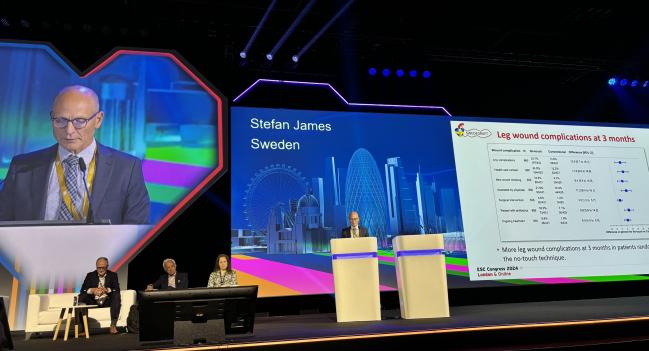No Go for No-Touch SVG Harvesting in CABG Surgery: SWEDEGRAFT
Researchers say that the current 2a recommendation to use no-touch harvesting should be downgraded in light of new evidence.

LONDON, England—The “no-touch” harvesting technique for patients undergoing CABG surgery using a saphenous vein graft does not lower the risk of graft failure but is associated with a significantly increased risk of wound complications.
Those are the conclusions of SWEDEGRAFT, a multicenter, registry-based randomized trial of 900 patients undergoing nonemergent CABG surgery, presented today during a Hot Line session at the European Society of Cardiology Congress 2024.
“No benefit, but significantly more harm,” said lead investigator Stefan James, MD (Uppsala University Hospital, Sweden), during a media briefing. “We think that this should change the recommendations.”
The 2018 European guidelines on myocardial revascularization state that no-touch vein harvesting should be considered when an open harvesting technique is used (2a recommendation, level of evidence B).
Patrick Myers, MD (Lausanne University Hospitals, Switzerland), secretary general of the European Association for Cardio-Thoracic Surgery, said there aren’t any solid data on the uptake of no-touch saphenous vein harvesting, noting that most centers go with the approach the team prefers. While the left internal thoracic artery (LITA) is the gold standard for grafts to the left anterior descending (LAD) artery, saphenous vein grafts are frequently used for non-LAD targets.
As for current guidelines, Myers agreed that they should be reconsidered. “I think the 2a recommendation is pretty strong,” he told TCTMD. “We have more and more conflicting data—maybe the benefit is not as strong as we thought.”
Vein Graft Failure
The Achilles’ heel of saphenous vein grafts is graft failure, and although patency rates have improved, it’s estimated that 50% to 60% of grafts fail by 10 years. Comparatively, 90% to 95% of arterial grafts remain patent over the same horizon. The no-touch vein harvesting technique, which involves minimal graft manipulation, was developed to remove the saphenous vein without causing trauma to the conduit. A small amount of surrounding tissue is left to prevent the vein from spasm and eliminate the need for vessel dilation.
“There are believers and nonbelievers, and it’s variable whether or not it’s used, but in many sites in Europe, and in the US as well, it’s used as a standard therapy in all patients,” said James.
There have been two randomized trials comparing no-touch and conventional vein graft harvesting. In one, Chinese researchers found there was improved patency with the no-touch approach over conventional open harvesting at 12 months. In SUPERIOR SVG, Canadian investigators failed to show a significant benefit with the no-touch technique, but did observe a higher rate of leg wound infections, including serious infections, with no-touch harvesting.
In SWEDEGRAFT, vein graft failure after a mean duration of 3.5 years from randomization occurred in 19.8% of patients treated with no-touch vein harvesting and 24.0% of those treated with the conventional technique (P = 0.15). Additionally, there was no significant difference in the composite endpoint of death, MI, or repeat revascularization between the two approaches (12.6% and 9.9% with no-touch and conventional harvesting; P = 0.195).
At 3 months, wound complications were significantly higher in patients treated with no-touch harvesting (24.7% vs 13.8%; absolute difference 10.9%; 95% CI 5.7-16.1%). Two years removed from the surgery, 49.6% of patients harvested with the no-touch technique reported still having leg wound symptoms, compared with 25.2% of those in the conventional harvesting group (absolute difference 24.4%; 95% CI 17.7-31.1%).
Get Better With More Experience?
Myers noted that proponents of no-touch saphenous vein grafts report mid-term patency rates approaching that of arterial grafts, suggesting these harvested veins could be used after grafting the LITA to LAD. For multiarterial grafting, the ARTS trial was negative, he noted, although there was a very high crossover rate between the two groups and the as-treated analysis showed a benefit with multiarterial grafting.
“Arterial grafting is spoken about quite a lot, but it's not frequently used,” James told TCTMD. “This is a Swedish trial, and it's rarely used. These patients, 99% had a [LITA-to-LAD] graft, but none of them had arterial grafts. That reflects clinical practice, at least in our part of the world.”
With SWEDEGRAFT, Myers said follow-up is still relatively short at 3.5 years, and that graft failure and MACE rates numerically, but not significantly, favored the no-touch approach. The difference in patency and clinical outcomes between the two techniques is relatively small, and even with 900 patients, the trial might be underpowered to detect a significant difference, he said.
The difference in wound complications, however, is “quite striking,” although a higher rate early after surgery would be expected given that more tissue is extracted. It’s possible operators were still early in the learning curve with the no-touch approach and complications could be lowered with more experience, he said.
Michael O’Riordan is the Managing Editor for TCTMD. He completed his undergraduate degrees at Queen’s University in Kingston, ON, and…
Read Full BioSources
James S, on behalf of the SWEDEGRAFT researchers. Nordic, multicenter, randomized, registry-based clinical trial on no-touch vein grafts in coronary surgery. Presented at: ESC Congress 2024. August 31, 2024. London, England.
Disclosures
- James and Myers reports no relevant conflicts of interest.






Comments